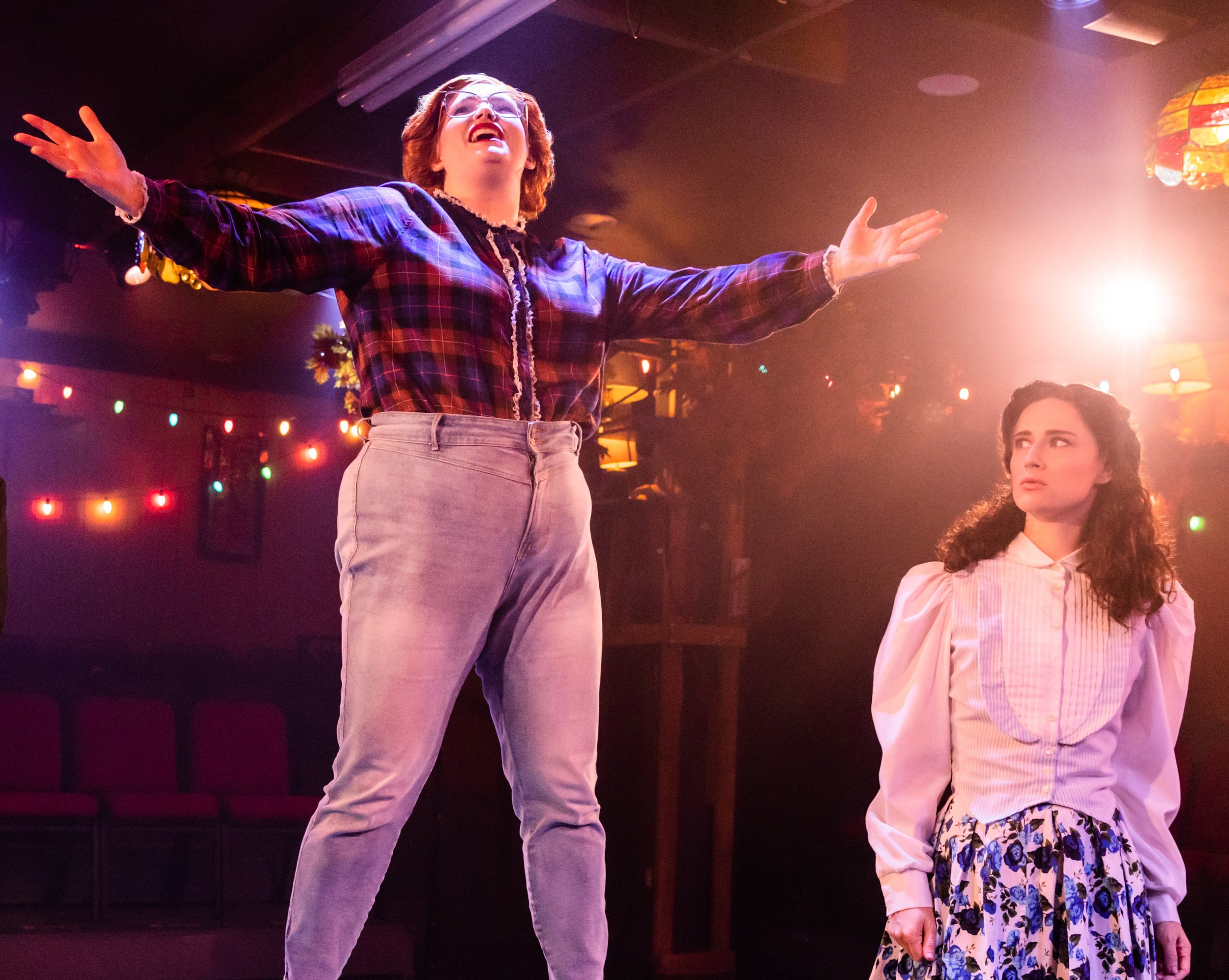Jeremiah Garcia (left), Jeffrey Laughrun (center), and Jamir Brown as Dustin, Mike, and Lucas in Stranger Sings, a musical spoof of the popular Netflix series Stranger Things.
When the fourth season of the Netflix hit Stranger Things premiered this past summer, it seemed like the show’s popularity had reached its zenith. From pushing a certain decades-old Kate Bush song back onto the Billboard Hot 100 to causing fangirls to rave online about the magnetism of breakout star Jamie Campbell Bower as Stranger’s newest baddie, the show’s powerful reach could rival the telekinetic abilities of one of the series’ other iconic characters, Eleven (Millie Bobbie Brown). So it’s only natural that a musical parody of the show about superpowered teens, demonic beings and alternate dimensions would be the next step—here called Stranger Sings!, of course.
As a show, Sings has battled its own fair share of demons, with a bulk of its music, book, and lyrics written by Jonathan Hogue during the COVID-19 lockdown. Following two previous incarnations, Sings has found a comfortable home in a refurbished church basement dressed in nostalgic 1980s fashion. In Walt Spangler’s immersive scenic design, the space is awash in knickknacks from 1983. There is a poster of Suzanne Somers from her workout-video phase, along with the requisite Dungeons & Dragons figurines on a table in Spangler’s in-the-round conception. Jamie Roderick’s spectacular lighting features resplendent fixtures reminiscent of Pizza Hut lamps of the era).
From left: Harley Seger as Eleven, Caroline Huerta as Joyce, and Shawn W. Smith as Hopper.
In fact, it is during a session of D&D in a basement that the central characters are introduced: 12-year-olds Mike (Jeffrey Laughrun), Dustin (Jeremiah Garcia), Lucas (Jamir Brown), and Will (here, as a puppet performed by Caroline Huerta). After Mike’s mom (Shawn Smith) cuts the fun short and the boys go their separate ways, Will suddenly goes missing. Stranger things have indeed happened in the fictional town of Hawkins, Ind.—with even more to come.
Subsequently, at a teen party, best friends Nancy (Harley Seger) and fan-favorite Barb (SLee) pronounce their undying friendship—only for Nancy to set her attention on Hawkins High hotshot Steve (Garrett Paladian) instead, leaving Barb vulnerable to mysterious unknown forces. From here, it’s a hilarious romp through the series’ first two seasons, with the group encountering the superpowered Eleven (Seger again), who helps the group, town sheriff Hopper (Smith), and Will’s mom Joyce (Huerta) in their mission to find Will and battle the demogorgons in an alternate dimension known as The Upside Down.
As a parody, the show balances the humor with some spot-on observations of the characters from the original series. Whether it’s Seger delivering Eleven’s signature monosyllabic responses (“It’s so cold and sad. Like some sort of scrappy church basement turned performance space. What’s all this floating white stuff in the air?” “Asbestos.”) or Huerta embodying Joyce’s crazed outbursts (“Hopper!! We don’t have time for you to explore your past trauma through song!! We need to find my boy!!”), Sings’ actors revel in sending up the cultural phenomenon.
“As a whole, ‘Sings’ unabashedly wears its musical theater roots on its sleeve.”
Sometimes those observations are heightened, as in the case of Brown’s Erica (Lucas’s younger sister), who vogues her way into ice cream shop Spoofs Ahoy with all the brio of a ballroom queen. Similarly, the series’ evil Dr. Brenner (Paladian) waltzes in with the snakelike grace of someone who works for a mysterious government operation—which, of course, he does. The effect is doubly hilarious.
Just like its source material, Sings peppers the show with various pop culture references. In addition to the series’ nods to properties such as E.T., The Goonies, and Firestarter, the musical winks at the audience with its own homages—from the films of Winona Ryder (who plays Joyce in the series) to Broadway shows currently running just blocks away. As a whole, Sings unabashedly wears its musical-theater roots on its sleeve, with jaunty opening numbers (“Welcome to Hawkins”) and cheesy falling-in-love tunes (“In These Woods”).
SLee as Barb (left) with Seger as Nancy. Photographs by Evan Zimmerman.
But it’s when Hogue fuses his tracks with other influences that the show really gets going. In a great tip-of-the-hat to Mama Rose in Gypsy (“Barb’s Turn”), actor SLee’s oft-ignored sidekick finally gets her due in a showstopping 11 o’clock number. And the suspenseful final act (“The Final Battle”) is underscored with the syncopated synths and gated drums that have become signatures of the series and the era it depicts, all amplified to rocking effect by Germán Martinez’s and Cosette Pin’s sound design.
Under Nick Flatto’s direction, the show’s overall rhythm runs smoothly, with lightning-quick costume changes and memorable exits and entrances (a fun one was Brown’s demogorgon dancing to Michael Jackson’s “Thriller”). Other aspects of Sing deserve mention as well: Matthew Solomon’s excellent costume designs, in particular, are, remarkably, straight out of the original series, and Ashley Marinelli’s choreography provides some clever movement throughout.
All in all, Stranger Sings: The Parody Musical is much like its televisual counterpart—one wild adventure best enjoyed with friends.
Stranger Sings: The Parody Musical has been extended through Aug. 13 at Playhouse 46 at St. Luke’s (308 West 46th St.). For more information, visit www.strangersingsthemusical.com.





